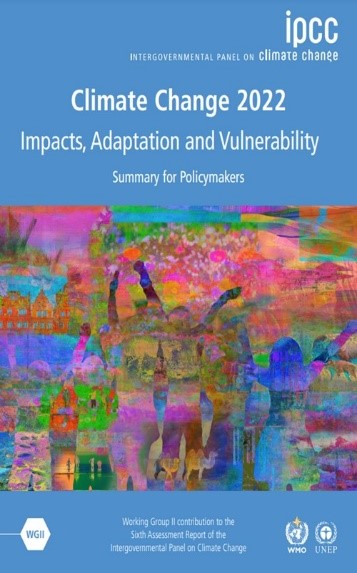Climate Change : Adaptation
Introduction

| The initial impacts of climate change were assessed by the Intergovernmental Panel on Climate Change (IPCC) in 1999 and these assessments have since been periodically updated, the most recent one being IPCC's Sixth Assessment Report (AR6) WG2 Climate Change 2022: Impacts, Adaptation and Vulnerability, published in February 2022. |
Adaptation — An International Concern
The Bali Action Plan adopted in 2007 at the thirteenth Conference of the Parties (COP13) of the United Nations Framework Convention on Climate Change (UNFCCC), identified "adaptation" as one of the four building blocks required for a strengthened future response to climate change. Adaptation is now recognized as an essential component to enhance resilience to the impacts of climate change. The building blocks below are meant to enable the full, effective and sustained implementation of the UNFCCC through long-term cooperative action.
The terms “adaptation” and “mitigation” describe two actions that are essential to tackle climate change. Figure below provides IPCC definitions to explain the difference between terms adaptation and mitigation.
Strongly linked with adaptation and mitigation concepts, resilience is defined by IPCC as "the ability of a social, ecological, or socio-ecological system and its components to anticipate, reduce, accommodate, or recover from the effects of a hazardous event or trend in a timely and efficient manner".
According to the IPCC AR6 Report, climate resilient development integrates adaptation measures and their enabling conditions with mitigation to advance sustainable development for all. Pathways for advancing climate resilient development are development trajectories that successfully integrate mitigation and adaptation actions to advance sustainable development.
Comprehensive, effective, and innovative responses can harness synergies and reduce trade-offs between adaptation and mitigation to advance sustainable development. Building climate resilience requires engagement of all actors (governments, civil society and private sector) having the capacity to anticipate climate risks and hazards, by developing innovative and transformational responses.
Adaptation and Aviation

| In an aviation context, climate adaptation involves adjusting, changing, or improving air traffic operations, and infrastructure to prepare for projected climate changes and to limit adverse impacts to an acceptable level. It may also include adjustments to schedules. It may also provide opportunities to take advantage of beneficial impacts. |
| | Aviation climate resilience is the ability for the aviation system operations and infrastructure to be able to withstand and recover from external perturbation resulting from the impacts of climate change. |
Therefore, anticipation of and adaptation to these impacts are vital to ensure a reduction in the magnitude of consequences of climate change to the whole aviation system.
| | For example, at airport level, the impact of increased temperature changes could increase the demand for cooling, effect the stability of paved surfaces, and even reduce aircraft performance. |
| | Air Navigation Service Providers (ANSPs) and aircraft operators already experience disruptions to air traffic operations, including delays and cancellations for weather events. Projected impacts of climate change are likely to increase these disruptions and increase the need for maintenance, repairs, and replacements of infrastructure. (see the ICAO Climate Adaptation Synthesis Report for more information on potential effects).
|
Under the umbrella of the Committee on Aviation Environmental Protection (CAEP), ICAO develops and disseminates guidance for States and aviation stakeholders to address the need for the global aviation sector to adapt to changing climate.
ICAO Guidance Documents on Adaptation
ICAO Climate Adaptation Synthesis Report – click to get more information
ICAO Climate Risk Assessment, Adaptation and Resilience Guidance - click to get more information
These three separate, but related documents provide guidance to States, and aviation organizations on how to conduct climate change risk assessments and develop adaptation and resilience measures. They provide an overview of key climate change vulnerabilities which aviation organisations may need to address and a "menu" of options for aviation stakeholders to consider in their own planning. Each report is a standalone document.
Co-Operation with Other Organizations
The United Nations Sand and Dust Storm (SDS) Coalition
Dust storms pose a significant hazard for aviation. Not only do they drastically reduce visibility, they also are associated with very strong winds that can seriously affect an aircraft in flight.
| | At the 24th Senior Officials Meeting of the EMG a Coalition was formed to combat Sand and Dust Storms (SDS), of which ICAO is also part of. This Coalition will promote and co-ordinate a collaborative UN-system response to SDS, on local, regional and global scales, ensuring unified and coherent actions are taken. The aim of the coalition is to improve the monitoring and response to these storms by: |
Conclusions
States and organizations are becoming increasingly aware of the potential risks associated with climate change and will have to incorporate these risks into their future planning and design their adaptation strategies accordingly.
ICAO has been leading the development of standards and recommended practices to improve aviation environmental protection since the 1960s, however it is certain that more ambitious mitigation and adaptation activities are still needed. Therefore, ICAO's role and commitment in supporting 193 Member States on climate change adaptation topic with referring to SDGs (Sustainable Development Goals) will continue to be a key in ICAO's work as the consequences of climate change need to be anticipated and effectively addressed.
